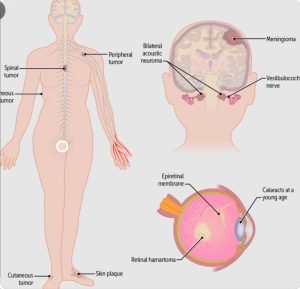
Neurofibromatosis Type 2
In rare cases, a patient may have tumors in both ears, which is known as neurofibromatosis type 2 (NF2). Early diagnosis using gadolinium-enhanced MRI together with hearing preservation techniques has improved our ability to prevent profound hearing loss and achieve total tumor removal.
This is a genetic condition with dominant inheritance, so family screening with DNA analysis helps in early diagnosis. Half of individuals with NF2 inherit it through an affected parent, and the other half appear to have the mutation for the first time in their family. Every child with an affected parent has a 50% chance of inheriting the disease. Unlike patients with unilateral vestibular schwannoma, effecting just one ear, NF2 affects both ears, and patients usually already have symptoms during adolescence and as young adults. They often also have naturally accompanying brain and spinal tumors.

These tumors can affect nerves involved in swallowing, speech, facial sensation, and facial and eye movement. Patients with NF2 may be offered complete surgical removal with hearing preservation, periodic observation without surgical intervention, tumor decompression without total resection, partial resection via the retrosigmoid approach, total resection via the translabyrinthine approach without hearing preservation, and cochlear implants or auditory brainstem implants.
For patients with large tumors or profound hearing loss, the brainstem implant allows for improved auditory function after tumor resection. In some cases, good results may be achieved with a cochlear implant.

